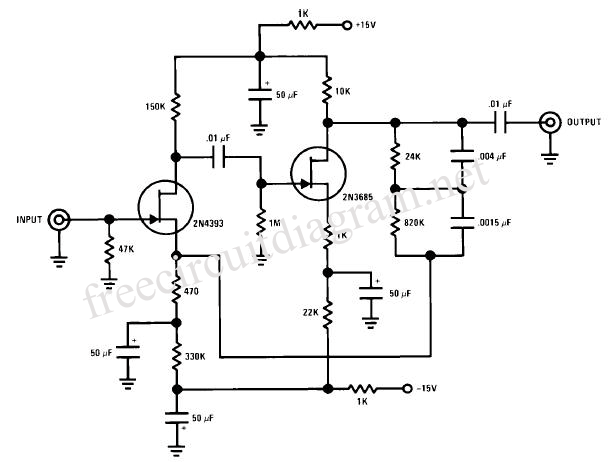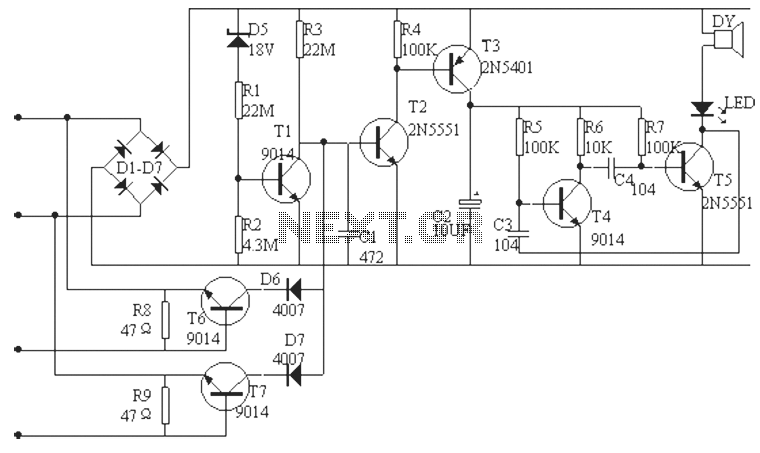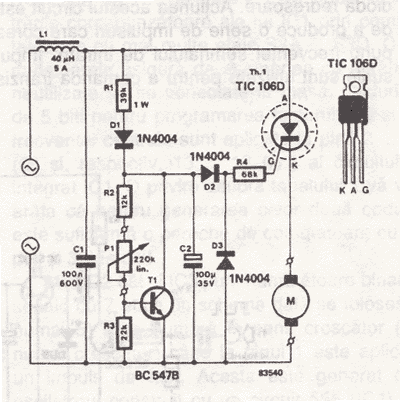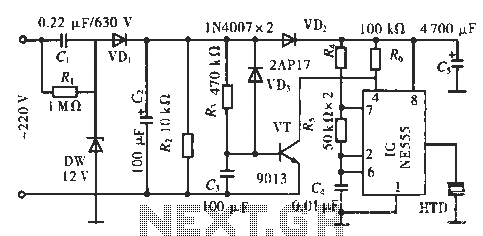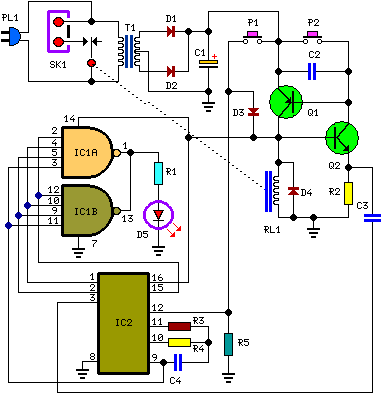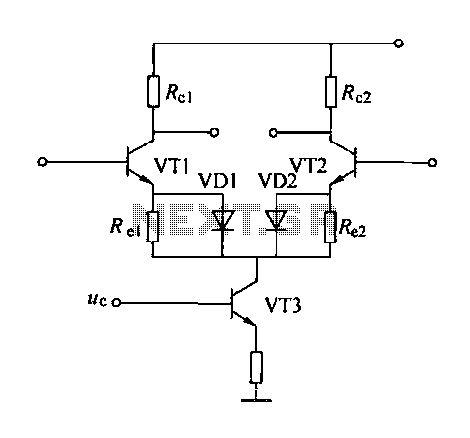
Circuit RF Amplifier
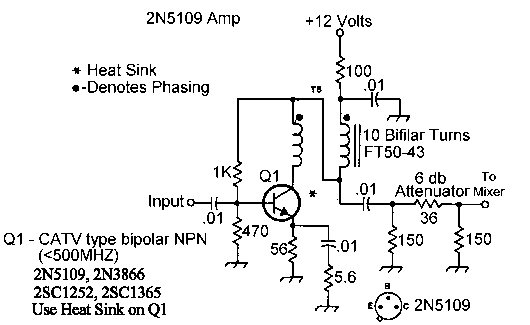
One of the most notable RF amplifiers documented is Wes Hayward's post-mixer amplifier in the Progressive Communications Receiver. It is recognized as a highly effective high-level RF amplifier, operating with a standing current of 50 mA, which allows it to handle strong signals without distortion. For further details, refer to page 15, figure 15.33 of the 2000 ARRL Handbook for Radio Amateurs. This receiver is engineered to perform optimally under challenging conditions, such as those faced by amateur radio operators living in condominiums or townhouses with antenna restrictions. Testing was conducted using a Hamstick antenna positioned just inside a bedroom window. A 16-18 dB RF amplifier was utilized to enhance sensitivity when using the Hamstick in such confined environments. When better antennas are deployed, the front-end gain must be adjusted according to the specific antenna system in use. In high-quality antenna systems, the RF amplifier may need to be bypassed and is recommended for use only on the 17-meter band. Instructions for bypassing the RF amplifier can be found at the bottom of the referenced page. The optimal gain level represents a balance between sensitivity and dynamic range; with a Hamstick, low signal levels necessitate prioritizing sensitivity for effective performance. An informative article, "Receiving Antennas" by Robert L. Nelson (K6ZGQ), published in Ham Radio in May 1970, discusses the advantages of using Hamsticks configured as dipoles. Nelson notes effective results with both helical dipoles and untuned five-foot-long dipoles with capacitive hats when connected through an antenna coupler, with the helical design offering superior performance. When mounted horizontally, the helical dipole is horizontally polarized, electrically sensitive, and provides good noise discrimination against local interference. Despite the receiver's ample gain for small antennas, proper tuning and matching to the 50-ohm input are essential. An antenna tuner is recommended for optimal performance with random wires. The Hamstick performs best at its designated frequency, and the 17-meter Hamstick offers consistent reception across all bands of the receiver. The ground connection was established using a #12 wire connected to plumbing pipes, while a counterpoise wire along the room's baseboard can also serve as a ground. Different Hamsticks yield varying results; for instance, a 30-meter Hamstick operates effectively on 17 meters but not on others, while a 20-meter Hamstick performs adequately on 40 meters but poorly on 30 meters. For general listening, a 17-meter Hamstick is advisable. To assess the appropriate gain at the RF stage, one should listen for signals through the speaker and monitor for 455 kHz IF strip noise. The receiver is designed to mask IF noise with signal levels entering the IF strip; a noticeable increase in background noise when tuning indicates sufficient amplification. Conversely, if band noise overwhelms the signal, additional loss in the 50-ohm pad may be required. A 3 dB pad is already integrated at the output of the RF amplifier, with higher loss pads available for use. Testing has shown that the receiver maintains consistent gain with or without the 3 dB pad, attributed to improved matching with the pad, as opposed to minor mismatches that could diminish signal strength. The inclusion of the 3 dB pad is recommended in all scenarios, while significant differences emerge with a 6 dB pad. The 50-ohm pad incorporated in the receiver is a Pi-Network Resistive Attenuator.
The described RF amplifier circuit is integral to enhancing the performance of the Progressive Communications Receiver, particularly in environments with limited antenna options. The use of a post-mixer amplifier configuration allows for effective signal amplification while maintaining low distortion levels. The standing current of 50 mA ensures robust performance, enabling the circuit to handle strong incoming signals without compromising the integrity of the output.
In practical applications, the circuit's design accommodates various antenna configurations, including the Hamstick, which is particularly beneficial in urban settings where space and regulations limit antenna deployment. The amplifier's gain can be adjusted based on the specific antenna used, allowing for fine-tuning that maximizes reception quality. The option to bypass the RF amplifier in high-quality antenna systems provides flexibility, ensuring that the receiver can adapt to different operational conditions.
Furthermore, the implementation of a 3 dB Pi-Network Resistive Attenuator at the output stage enhances signal integrity by minimizing reflections and improving impedance matching. This adjustment is crucial in maintaining consistent performance across different frequency bands. The careful selection of additional components, such as an antenna tuner and counterpoise arrangements, further optimizes the receiver's functionality, ensuring that it can perform effectively even with non-ideal antennas.
Overall, the circuit exemplifies a well-thought-out design that prioritizes performance in challenging conditions, making it an essential tool for amateur radio operators seeking reliable communication capabilities.One of the best RF amplifiers ever published was Wes Hayward`s post mixer amplifier in the Progressive Communications Receiver. It quickly became known as a great high level RF amplifier. With a standing current of 50ma, it takes a very strong signal to upset this amplifier. Check out page 15. 24, figure 15. 33 of the 2000 ARRL Handbook for Radio Amateurs for more information. This receiver is designed to work in the worst conditions that many hams have to tolerate: living in a condo or townhouse with antenna restrictions. A Hamstick antenna mounted just inside a bedroom window (in a townhouse) was used to test the sensitivity of the receiver.
A 16-18dB RF amplifier was used to provide the necessary sensitivity to work with a hamstick in a townhouse/condo. When this receiver is used with better antennas, the front end gain needs to be "tuned" for the antenna system used.
The RF amplifier needs to be bypassed in really good antenna systems, and maybe used only on the 17 meter band. Instructions for bypassing the RF amplifier are near the bottom of this page. The right amount of gain is a compromise between sensitivity and dynamic range. When using a Hamstick, signal levels are so low that going all the way for sensitivity gives a very good performing setup.
An excellent article that shows the effectiveness of using Hamsticks in a dipole configuration is "Receiving Antennas", by Robert L. Nelson, K6ZGQ, Ham Radio, May 1970, pp 56-63 (Subtitled: "A discussion of special purpose antennas for receiving - including some novel ideas for improved performance on the lower bands").
Mr. Nelson states, from the article above (page 62), "I have obtained good results with both a helical dipole and an untuned five-foot-long dipole with a capacitive hat when worked through an antenna coupler. However, the helical arrangement is somewhat better. " Again, on the helical dipole (page 62), "This antenna, if mounted horizontally, will be horizontally polarized, electrical-field sensitive and balanced with respect to ground, and will discriminate rather well against local noise.
" Even though this receiver has plenty of gain to work with small antennas, they must be tuned and matched to the 50 ohm input of the receiver. An antenna tuner must be used with random wires for best results. A Hamstick used at its design frequency gives the best reception. However, a 17 meter Hamstick gives even reception throughout all the bands of this receiver. My ground lead was a #12 wire to the pipes in the bathroom. A counterpoise wire run along the baseboard of a room will also work as a ground. Other Hamsticks give different results. A 30 meter Hamstick will work on 17 meters, but on none of the others. A 20 meter Hamstick will work ok on 40 meters, but hardly at all on 30. A 40 meter Hamstick will not work very well on 20 meters, etc. For general listening, use a 17 meter hamstick. To gage proper gain at the RF stage, listen to the signal in the speaker and check for 455 kHz IF strip noise.
This receiver was designed so IF noise is masked by the signal levels entering the IF strip. If you do not get a definite rise in background noise when tuning a band with the bandpass filter pot, more amplification is needed. If the band noise blows you off the table, add more loss in the 50 ohm pad. A 3dB pad is installed at the output of the RF amplifier. Higher loss pads may be used. Tests on loss/gain through the front end and bandpass filters indicate the receiver has the same gain with or without the 3 dB pad.
The reason surmised is that the gain is improved by better matching with the 3dB pad versus a little mismatch that loses some signal strength without the pad. The 3dB pad is recommended in every situation. Real differences begin with a 6db pad. The 50 ohm pad used in the receiver is a Pi-Network Resistive Attenuator. The following are some values that would be useful in this receiver. Reference for th 🔗 External reference
The described RF amplifier circuit is integral to enhancing the performance of the Progressive Communications Receiver, particularly in environments with limited antenna options. The use of a post-mixer amplifier configuration allows for effective signal amplification while maintaining low distortion levels. The standing current of 50 mA ensures robust performance, enabling the circuit to handle strong incoming signals without compromising the integrity of the output.
In practical applications, the circuit's design accommodates various antenna configurations, including the Hamstick, which is particularly beneficial in urban settings where space and regulations limit antenna deployment. The amplifier's gain can be adjusted based on the specific antenna used, allowing for fine-tuning that maximizes reception quality. The option to bypass the RF amplifier in high-quality antenna systems provides flexibility, ensuring that the receiver can adapt to different operational conditions.
Furthermore, the implementation of a 3 dB Pi-Network Resistive Attenuator at the output stage enhances signal integrity by minimizing reflections and improving impedance matching. This adjustment is crucial in maintaining consistent performance across different frequency bands. The careful selection of additional components, such as an antenna tuner and counterpoise arrangements, further optimizes the receiver's functionality, ensuring that it can perform effectively even with non-ideal antennas.
Overall, the circuit exemplifies a well-thought-out design that prioritizes performance in challenging conditions, making it an essential tool for amateur radio operators seeking reliable communication capabilities.One of the best RF amplifiers ever published was Wes Hayward`s post mixer amplifier in the Progressive Communications Receiver. It quickly became known as a great high level RF amplifier. With a standing current of 50ma, it takes a very strong signal to upset this amplifier. Check out page 15. 24, figure 15. 33 of the 2000 ARRL Handbook for Radio Amateurs for more information. This receiver is designed to work in the worst conditions that many hams have to tolerate: living in a condo or townhouse with antenna restrictions. A Hamstick antenna mounted just inside a bedroom window (in a townhouse) was used to test the sensitivity of the receiver.
A 16-18dB RF amplifier was used to provide the necessary sensitivity to work with a hamstick in a townhouse/condo. When this receiver is used with better antennas, the front end gain needs to be "tuned" for the antenna system used.
The RF amplifier needs to be bypassed in really good antenna systems, and maybe used only on the 17 meter band. Instructions for bypassing the RF amplifier are near the bottom of this page. The right amount of gain is a compromise between sensitivity and dynamic range. When using a Hamstick, signal levels are so low that going all the way for sensitivity gives a very good performing setup.
An excellent article that shows the effectiveness of using Hamsticks in a dipole configuration is "Receiving Antennas", by Robert L. Nelson, K6ZGQ, Ham Radio, May 1970, pp 56-63 (Subtitled: "A discussion of special purpose antennas for receiving - including some novel ideas for improved performance on the lower bands").
Mr. Nelson states, from the article above (page 62), "I have obtained good results with both a helical dipole and an untuned five-foot-long dipole with a capacitive hat when worked through an antenna coupler. However, the helical arrangement is somewhat better. " Again, on the helical dipole (page 62), "This antenna, if mounted horizontally, will be horizontally polarized, electrical-field sensitive and balanced with respect to ground, and will discriminate rather well against local noise.
" Even though this receiver has plenty of gain to work with small antennas, they must be tuned and matched to the 50 ohm input of the receiver. An antenna tuner must be used with random wires for best results. A Hamstick used at its design frequency gives the best reception. However, a 17 meter Hamstick gives even reception throughout all the bands of this receiver. My ground lead was a #12 wire to the pipes in the bathroom. A counterpoise wire run along the baseboard of a room will also work as a ground. Other Hamsticks give different results. A 30 meter Hamstick will work on 17 meters, but on none of the others. A 20 meter Hamstick will work ok on 40 meters, but hardly at all on 30. A 40 meter Hamstick will not work very well on 20 meters, etc. For general listening, use a 17 meter hamstick. To gage proper gain at the RF stage, listen to the signal in the speaker and check for 455 kHz IF strip noise.
This receiver was designed so IF noise is masked by the signal levels entering the IF strip. If you do not get a definite rise in background noise when tuning a band with the bandpass filter pot, more amplification is needed. If the band noise blows you off the table, add more loss in the 50 ohm pad. A 3dB pad is installed at the output of the RF amplifier. Higher loss pads may be used. Tests on loss/gain through the front end and bandpass filters indicate the receiver has the same gain with or without the 3 dB pad.
The reason surmised is that the gain is improved by better matching with the 3dB pad versus a little mismatch that loses some signal strength without the pad. The 3dB pad is recommended in every situation. Real differences begin with a 6db pad. The 50 ohm pad used in the receiver is a Pi-Network Resistive Attenuator. The following are some values that would be useful in this receiver. Reference for th 🔗 External reference
